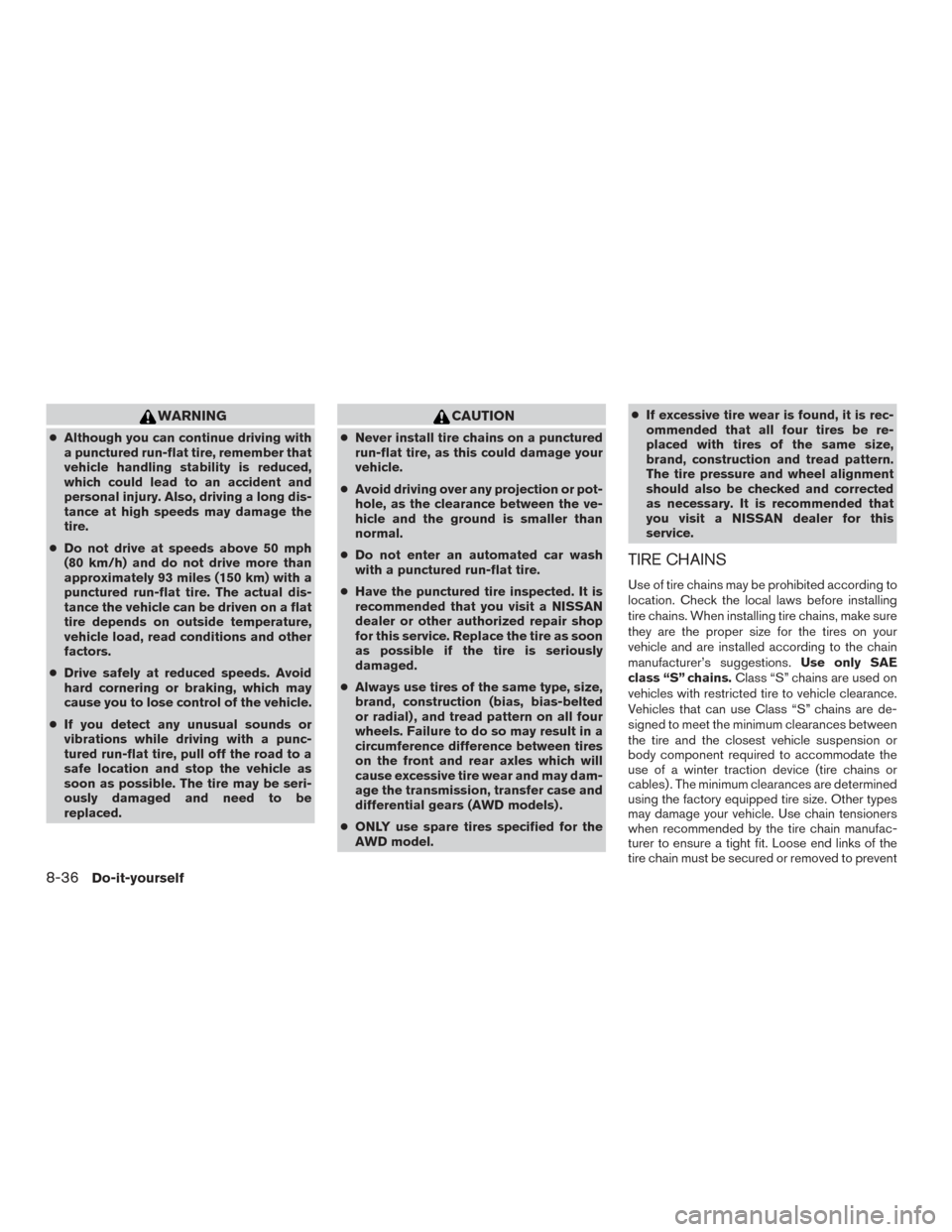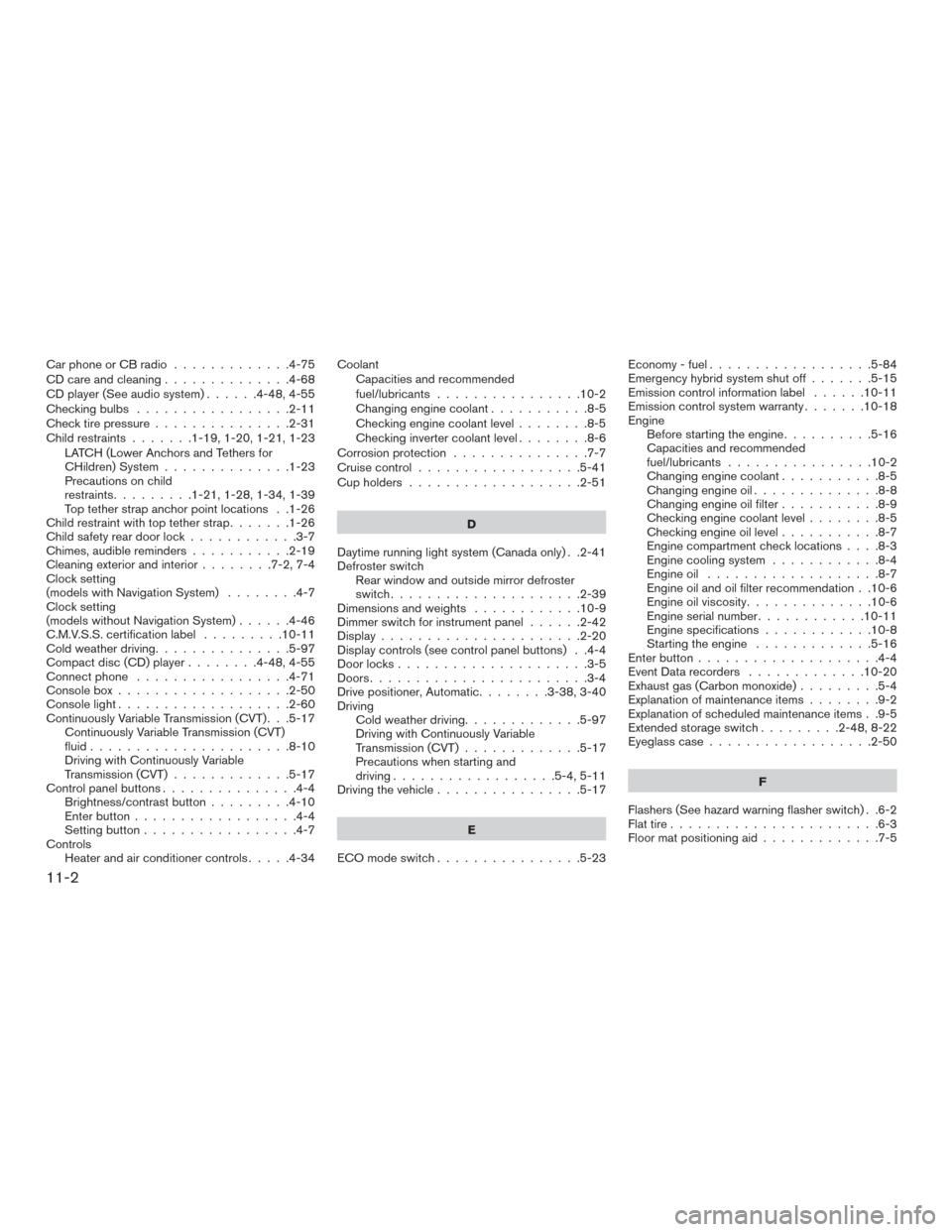Page 467 of 520

WARNING
●Although you can continue driving with
a punctured run-flat tire, remember that
vehicle handling stability is reduced,
which could lead to an accident and
personal injury. Also, driving a long dis-
tance at high speeds may damage the
tire.
● Do not drive at speeds above 50 mph
(80 km/h) and do not drive more than
approximately 93 miles (150 km) with a
punctured run-flat tire. The actual dis-
tance the vehicle can be driven on a flat
tire depends on outside temperature,
vehicle load, read conditions and other
factors.
● Drive safely at reduced speeds. Avoid
hard cornering or braking, which may
cause you to lose control of the vehicle.
● If you detect any unusual sounds or
vibrations while driving with a punc-
tured run-flat tire, pull off the road to a
safe location and stop the vehicle as
soon as possible. The tire may be seri-
ously damaged and need to be
replaced.
CAUTION
●Never install tire chains on a punctured
run-flat tire, as this could damage your
vehicle.
● Avoid driving over any projection or pot-
hole, as the clearance between the ve-
hicle and the ground is smaller than
normal.
● Do not enter an automated car wash
with a punctured run-flat tire.
● Have the punctured tire inspected. It is
recommended that you visit a NISSAN
dealer or other authorized repair shop
for this service. Replace the tire as soon
as possible if the tire is seriously
damaged.
● Always use tires of the same type, size,
brand, construction (bias, bias-belted
or radial) , and tread pattern on all four
wheels. Failure to do so may result in a
circumference difference between tires
on the front and rear axles which will
cause excessive tire wear and may dam-
age the transmission, transfer case and
differential gears (AWD models) .
● ONLY use spare tires specified for the
AWD model. ●
If excessive tire wear is found, it is rec-
ommended that all four tires be re-
placed with tires of the same size,
brand, construction and tread pattern.
The tire pressure and wheel alignment
should also be checked and corrected
as necessary. It is recommended that
you visit a NISSAN dealer for this
service.
TIRE CHAINS
Use of tire chains may be prohibited according to
location. Check the local laws before installing
tire chains. When installing tire chains, make sure
they are the proper size for the tires on your
vehicle and are installed according to the chain
manufacturer’s suggestions. Use only SAE
class “S” chains. Class “S” chains are used on
vehicles with restricted tire to vehicle clearance.
Vehicles that can use Class “S” chains are de-
signed to meet the minimum clearances between
the tire and the closest vehicle suspension or
body component required to accommodate the
use of a winter traction device (tire chains or
cables) . The minimum clearances are determined
using the factory equipped tire size. Other types
may damage your vehicle. Use chain tensioners
when recommended by the tire chain manufac-
turer to ensure a tight fit. Loose end links of the
tire chain must be secured or removed to prevent
8-36Do-it-yourself
Page 498 of 520
WHEELS AND TIRES
Wheel typeSize
Aluminum 17 x 7J
18x7J
Tires Size
Non Run Flat 225/65R17
225/60R18
Spare tires Size
Spare Wheel - Steel T155/90D17
DIMENSIONS AND WEIGHTS
Overall length 184.5 (4,686)
Overall width in (mm)72.4 (1,840)
Overall height with All-wheel drive in (mm)68.4 (1,737)
with front wheel drive in (mm)67.6 (1,717)
Front and Rear Track in (mm)62.8 (1,595.1)
Wheelbase in (mm)106.5 (2,706)
Gross vehicle weight rating lb (kg) Refer to the “F.M.V.S.S./C.M.
V.S.S. certification label” on
the center pillar between the driver’s side front and rear doors.
Gross axle weight rating
Front lb (kg)
Rear lb (kg)
Technical and consumer information10-9
Page 513 of 520

Car phone or CB radio.............4-75
CD care and cleaning ..............4-68
CD player (See audio system) ......4-48,4-55
Checkingbulbs .................2-11
Check tire pressure ...............2-31
Child restraints .......1-19,1-20,1-21,1-23
LATCH (Lower Anchors and Tethers for
CHildren) System ..............1-23
Precautions on child
restraints.........1-21,1-28,1-34,1-39
Top tether strap anchor point locations . .1-26
Child restraint with top tether strap .......1-26
Child safety rear door lock ............3-7
Chimes, audible reminders ...........2-19
Cleaningexteriorandinterior........7-2,7-4
Clock setting
(models with Navigation System) ........4-7
Clock setting
(models without Navigation System) ......4-46
C.M.V.S.S. certification label .........10-11
Cold weather driving ...............5-97
Compact disc (CD) player ........4-48,4-55
Connect phone .................4-71
Consolebox...................2-50
Consolelight...................2-60
Continuously Variable Transmission (CVT) . . .5-17 Continuously Variable Transmission (CVT)
fluid ......................8-10
Driving with Continuously Variable
Transmission (CVT) .............5-17
Control panel buttons ...............4-4
Brightness/contrast button .........4-10
Enterbutton..................4-4
Setting button .................4-7
Controls Heater and air conditioner controls .....4-34Coolant
Capacities and recommended
fuel/lubricants ................10-2
Changingenginecoolant...........8-5
Checking engine coolant level ........8-5
Checking inverter coolant level ........8-6
Corrosion protection ...............7-7
Cruisecontrol..................5-41
Cupholders...................2-51
D
Daytime running light system (Canada only) . .2-41
Defroster switch Rear window and outside mirror defroster
switch.....................2-39
Dimensionsandweights ............10-9
Dimmer switch for instrument panel ......2-42
Display......................2-20
Display controls (see control panel buttons) . .4-4
Door locks .....................3-5
Doors ........................3-4
Drive positioner, Automatic ........3-38,3-40
Driving Cold weather driving .............5-97
Driving with Continuously Variable
Transmission (CVT) .............5-17
Precautions when starting and
driving ..................5-4,5-11
Driving the vehicle ................5-17
E
ECO mode switch ................5-23 Economy-fuel..................5-84
Emergency hybrid system shut off
.......5-15
Emission control information label ......10-11
Emission control system warranty .......10-18
Engine Before starting the engine ..........5-16
Capacities and recommended
fuel/lubricants ................10-2
Changing engine coolant ...........8-5
Changingengineoil..............8-8
Changing engine oil filter ...........8-9
Checking engine coolant level ........8-5
Checking engine oil level ...........8-7
Engine compartment check locations ....8-3
Engine cooling system ............
8
-4
Engineoil ...................8-7
Engine oil and oil filter recommendation . .10-6
Engine oil viscosity ..............10-6
Engine serial number ............10-11
Engine specifications ............10-8
Starting the engine .............5-16
Enter button ....................4-4
Event Data recorders .............10-20
Exhaust gas (Carbon monoxide) .........5-4
Explanation of maintenance items ........9-2
Explanation of scheduled maintenance items . .9-5
Extended storage switch .........2-48,8-22
Eyeglass case ..................2-50
F
Flashers (See hazard warning flasher switch) . .6-2
Flat tire .......................6-3
Floor mat positioning aid .............7-5
11-2